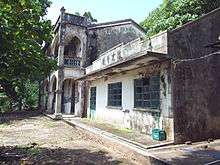Kuk Po

Kuk Po (Chinese: 谷埔; pinyin: Gŭ Bù) is situated in the north eastern New Territories of Hong Kong, to the south of the Starling Inlet (Shataukok Hoi, Sha Tau Kok Hoi), opposite the town of Shataukok.
History
By accounts given by villagers, the area was originally inhabited by the Cheung (張) clan who now reside in Fung Hang, and this is supported by much of the land in Kuk Po being owned by the Cheung. The Cheung may have been the original inhabitants prior to the 1662 evacuation of the coastal regions under the Kangxi Emperor of the Qing dynasty. All the coastal inhabitants had to move fifty li from the coast. Two years later a further evacuation further inland was ordered. It was not until 1669 that this evacuation was rescinded, and the depopulated coastal regions could be re-inhabited. The Kangxi Emperor decreed some financial assistance to help with the repopulation efforts, and it is probably due to this measure that newcomers came to Kuk Po and surrounding areas to live.
For over three centuries, the area of Kuk Po has been inhabited by seven clans, the Sung (宋), Lee (李), Ho (何), Tsang (曾), Cheng (鄭), Ng (吳) and Yeung (楊). There are a number of smaller villages under the geographical name Kuk Po, and these are (romanised names are the Hakka pronunciation) Hoi Ha (海下), Tien Sim (田心), Lau Vui (老圍), Sin Vuk Ha (新屋下), NgiDu (or Yito) (二肚), Sam Du (or Samto) (三肚), Si Du( or Szeto) (四肚), Ng Du(or Ngto) (五肚). Some like Lau Vui, Tien Sim and Sam Du are mixed clan, but the others are villages of one clan. All inhabitants of Kuk Pu are generally from a farming background. Living close to the inlet means that many of the people also enjoy fishing and gathering shellfish.
Kuk Po boasts a rural school house. It was built in the 1928, inspired by the Guangzhou Military Academy School, and is firmly connected with Sung Miau On, who became the local Kuk Po school headmaster. Sung Miao On was not originally from Kuk Po, but had studied in Guangzhou at the Military Academy School. He came to Kuk Po and identified with the people there who were of the same clan as he was. The school was still in use until the early 1990s, with the last headmaster Mr. Ho and a couple of teachers, and a few children who travelled across the bay to attend school every day.
By that time, the rural inhabitants of Kuk Po had moved to live in other areas. They continued to maintain their links with the village with some visiting frequently, and some coming on the first and fifteenth of the lunar months and festivities to observe pray and offerings to ancestors and the gods of the home and hearth.
Today, though the villages in Kuk Po are mostly deserted, there is tourism of a kind with hill walkers passing through the area from their mountain trail excursions from the nearby Plover Cove Country Park which fringes the Kuk Po valley. A stall near to the school is open every Sunday to cater for the travellers, owned by local indigenous Kuk Po people.
The rural decline of Kuk Po is reflected in other village areas in remote and almost inaccessible areas, such as So Lo Pun. To reach Kuk Po from the outside, local residents require to pass through the Shek Chung O border crossing with a permit. This is because Sha Tau Kok lies within a restricted border region. Moreover, it requires taking a ferry boat journey across the Stirling Inlet to reach the pier at Kuk Po Hoi Ha. This is because the trackway from Luk Keng is impractical, though some residents are known to use it, it is more usual for people to take a boat across. For mountail trail trekkers, the route is via the Country Park.
The inhabitants of Kuk Po are Hakka speakers like the surrounding villages and many people in the town of Shataukok. Many of those who were educated in Kuk Po since the 1970s are bilingual in Hakka and Cantonese.
There is a trackway which leads from the school in Kuk Po towards Fung Hang, and it takes travellers towards Kai Kuk Shue Ha and Ham Hang Mei, and out to Luk Keng where there is public transport available. The journey on foot can take around forty minutes to three quarters of an hour.
See also
References
- New Peace County, A Chinese Gazetteer of the Hong Kong Region. Peter Y.L. Ng. Hong Kong University Press, ISBN 962-209-043-5, (1983).
External links
| Wikimedia Commons has media related to Kuk Po. |
Coordinates: 22°31′38.38″N 114°14′13.65″E / 22.5273278°N 114.2371250°E